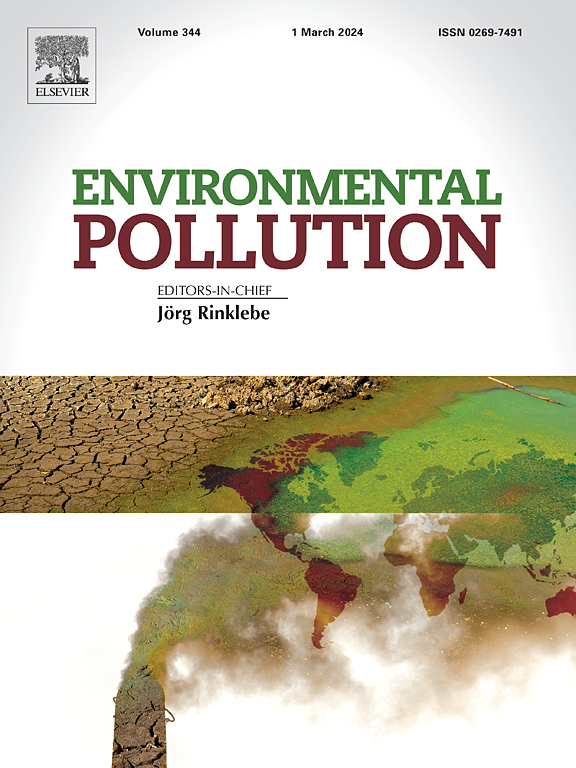玉米叶片中灭虫威和硼酸钠残留向土壤的转移及其对土壤微生物的影响
IF 7.3
2区 环境科学与生态学
Q1 ENVIRONMENTAL SCIENCES
引用次数: 0
摘要
与农药接触过的植物材料可能会进入土壤,对非目标土壤生物构成潜在风险,从而影响土壤功能。研究了玉米叶片施用两种农药对土壤微生物群落、活性和功能的影响。在玉米鲜叶和陈年玉米叶中单独或联合施用除草剂灭硫威(PSC)和杀菌剂boscalid (BSC)。在56天的培养过程中,我们量化了土壤和玉米叶片中的农药残留,以及玉米来源的碳在不同微生物组分(CO2、可提取有机碳、微生物生物量和主要微生物群)中的含量。56 d后,玉米和土壤中灭虫威残留量降至5%以下。然而,BSC残留物从玉米转移到土壤中,土壤中BSC残留物增加了约15%。灭虫威最初抑制土壤细菌磷脂合成25- 45%,同时使微生物生物量中玉米来源的碳含量减少68- 70%。在此之后,微生物将其养分获取策略转向碳和磷,从而增加了对容易获得的玉米来源的C. Boscalid的利用,短暂地抑制了土壤真菌的生长,降低了土壤呼吸和玉米的矿化。在未来的风险评估中,需要考虑农药从植物物质转移到土壤中的积累以及对土壤微生物的作用方式依赖效应。本文章由计算机程序翻译,如有差异,请以英文原文为准。


Transfer of prosulfocarb and boscalid residues from maize leaves to soil and their effects on soil microorganisms
Plant materials that have been in contact with pesticides can be incorporated into the soil, posing a potential risk to non-target soil organisms and, hence, soil functions. This study investigated effects of two pesticides applied to maize leaves on the soil microbial community, activity and function. The herbicide prosulfocarb (PSC) and the fungicide boscalid (BSC) were applied alone or in combination to fresh or aged maize leaves, which were incorporated into soil. During a 56-day incubation we quantified pesticide residues in soil and maize leaves as well as maize-derived C incorporation into different microbial fractions (CO2, extractable organic carbon, microbial biomass and main microbial groups). Prosulfocarb residues on maize and in soil decreased to below 5 % after 56 days. However, BSC residues were transferred from maize into the soil, as indicated by an increase in BSC residues in soil of around 15 %. Prosulfocarb initially inhibited the synthesis of soil bacterial phospholipids by 25–45 %, which was accompanied by a decrease in the incorporation of maize-derived C into microbial biomass by 68–70 %. Following this, microorganisms shifted their nutrient acquisition strategy towards carbon and phosphorus, which led to increased utilization of easily available maize-derived C. Boscalid transiently inhibited the growth of soil fungi, reduced soil respiration, and mineralization of maize. In the future, pesticide accumulation through transfer from plant material into soils and the mode of action dependent effects on soil microorganisms need to be considered for risk assessment.
求助全文
通过发布文献求助,成功后即可免费获取论文全文。
去求助
来源期刊

Environmental Pollution
环境科学-环境科学
CiteScore
16.00
自引率
6.70%
发文量
2082
审稿时长
2.9 months
期刊介绍:
Environmental Pollution is an international peer-reviewed journal that publishes high-quality research papers and review articles covering all aspects of environmental pollution and its impacts on ecosystems and human health.
Subject areas include, but are not limited to:
• Sources and occurrences of pollutants that are clearly defined and measured in environmental compartments, food and food-related items, and human bodies;
• Interlinks between contaminant exposure and biological, ecological, and human health effects, including those of climate change;
• Contaminants of emerging concerns (including but not limited to antibiotic resistant microorganisms or genes, microplastics/nanoplastics, electronic wastes, light, and noise) and/or their biological, ecological, or human health effects;
• Laboratory and field studies on the remediation/mitigation of environmental pollution via new techniques and with clear links to biological, ecological, or human health effects;
• Modeling of pollution processes, patterns, or trends that is of clear environmental and/or human health interest;
• New techniques that measure and examine environmental occurrences, transport, behavior, and effects of pollutants within the environment or the laboratory, provided that they can be clearly used to address problems within regional or global environmental compartments.
 求助内容:
求助内容: 应助结果提醒方式:
应助结果提醒方式:


